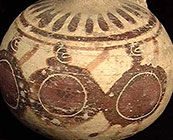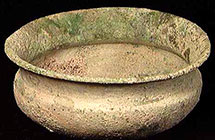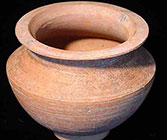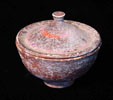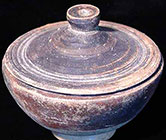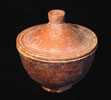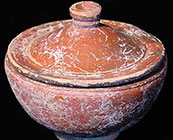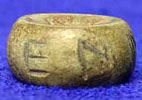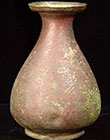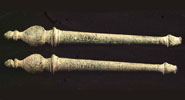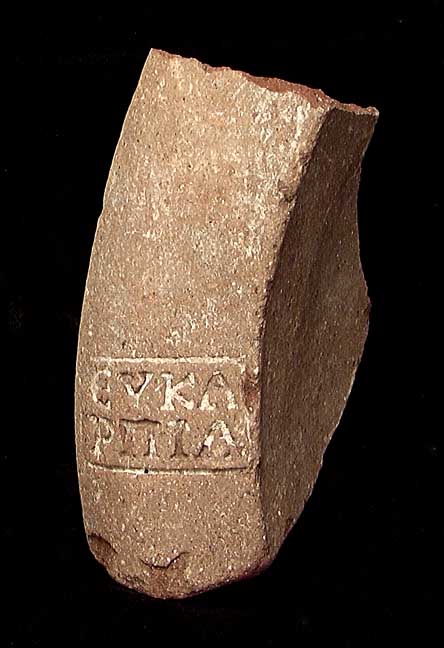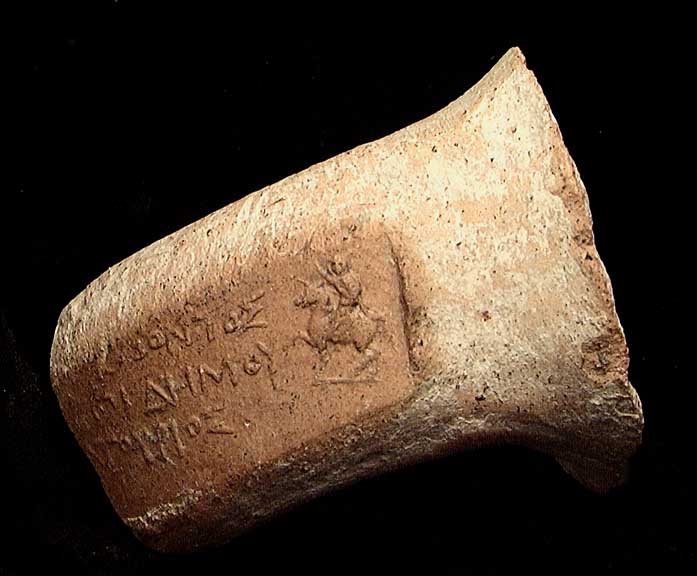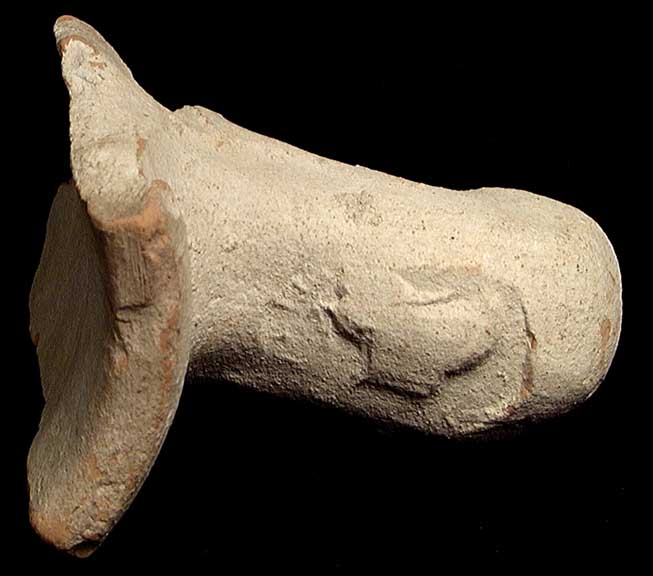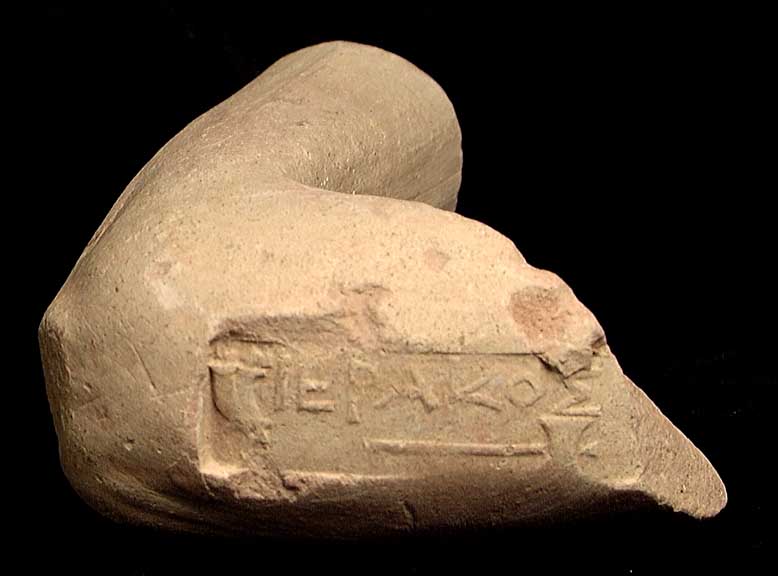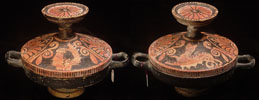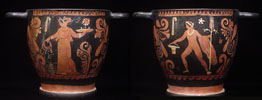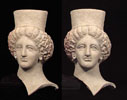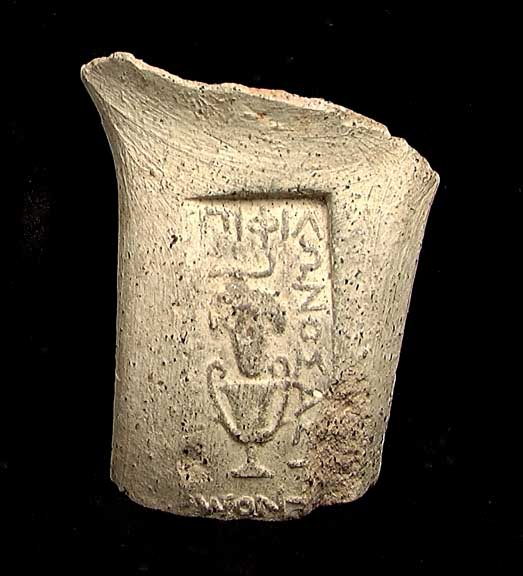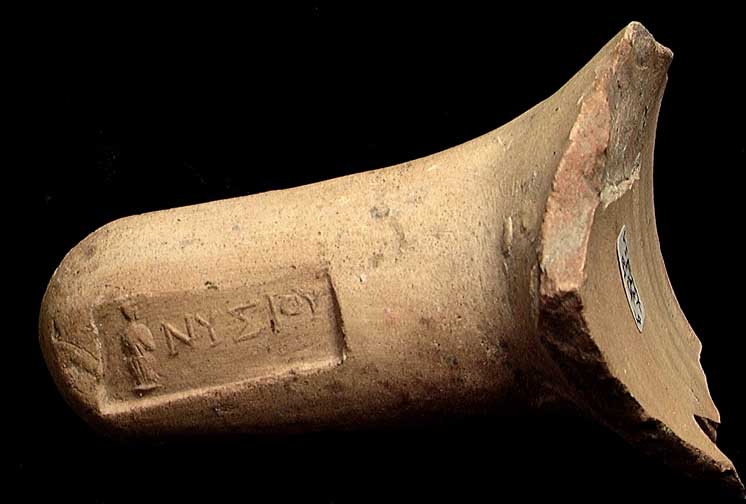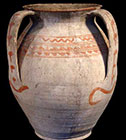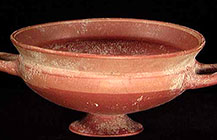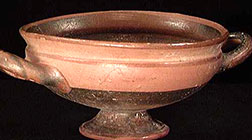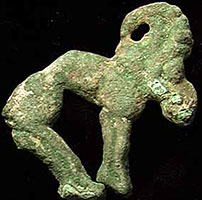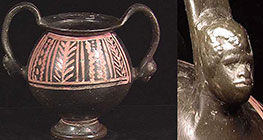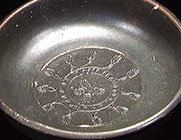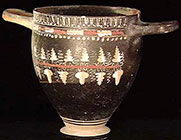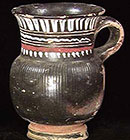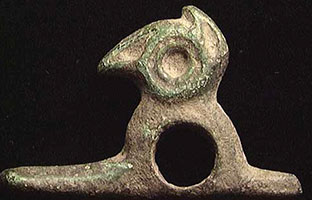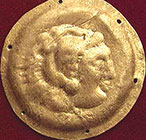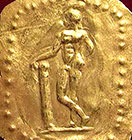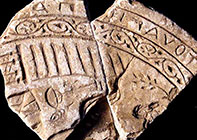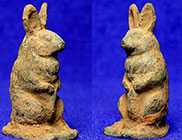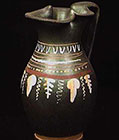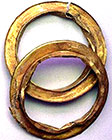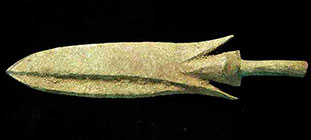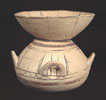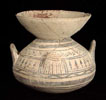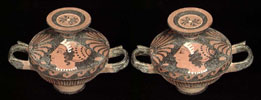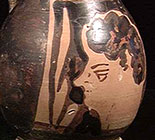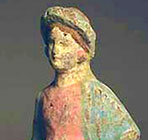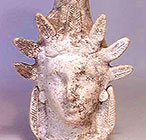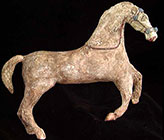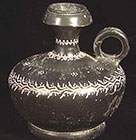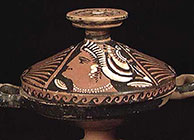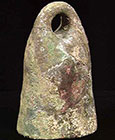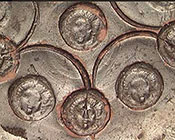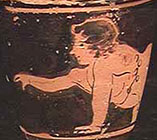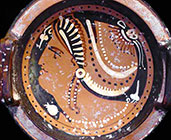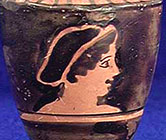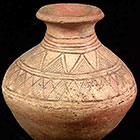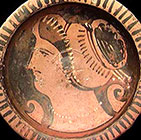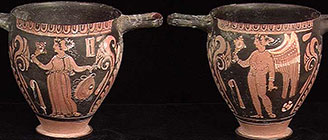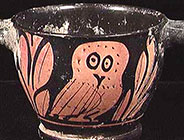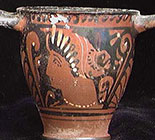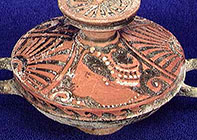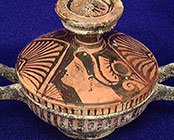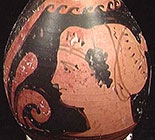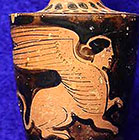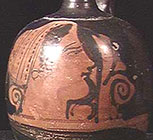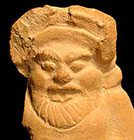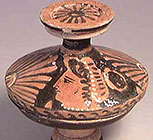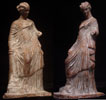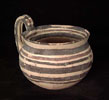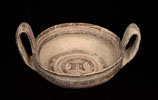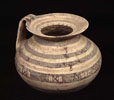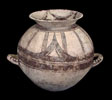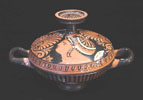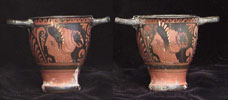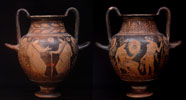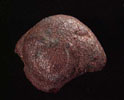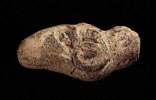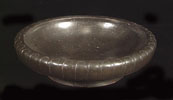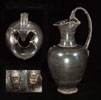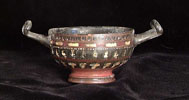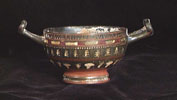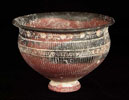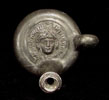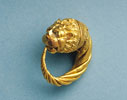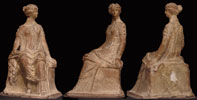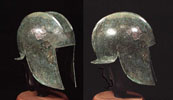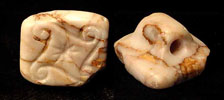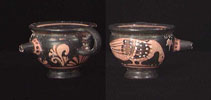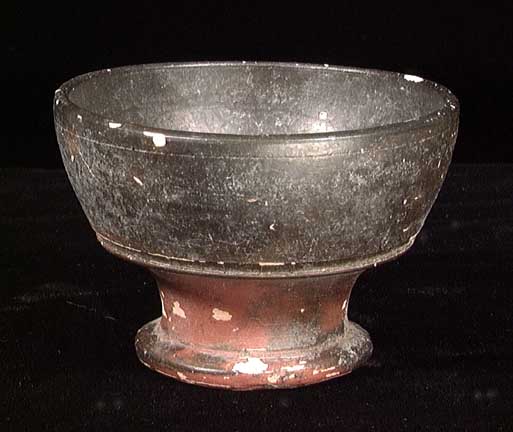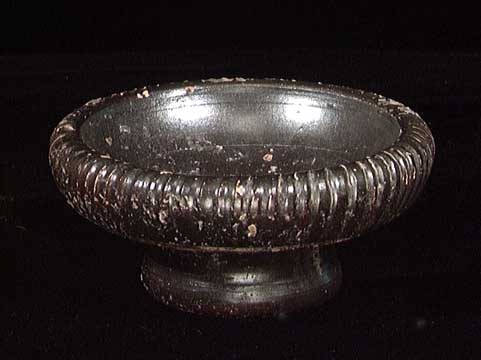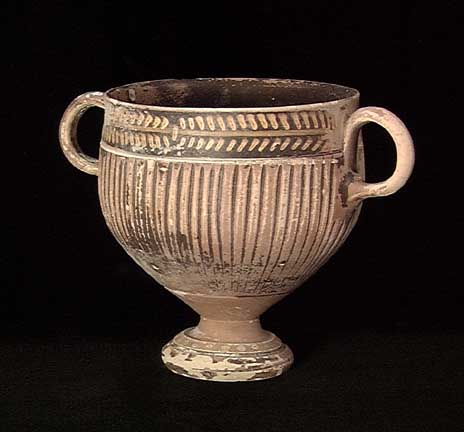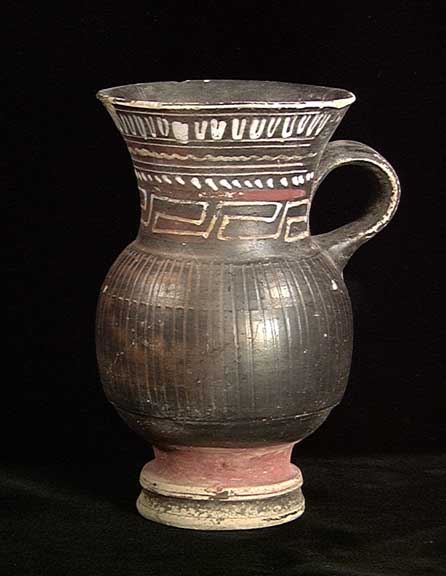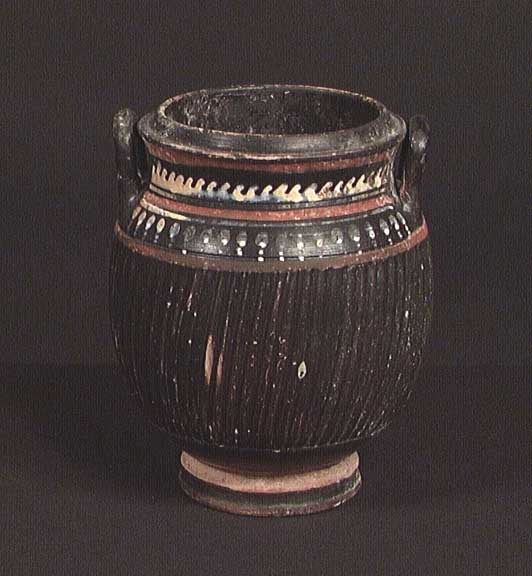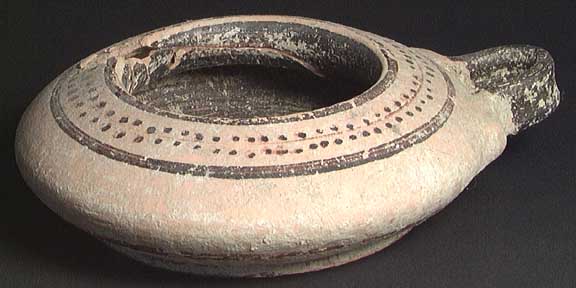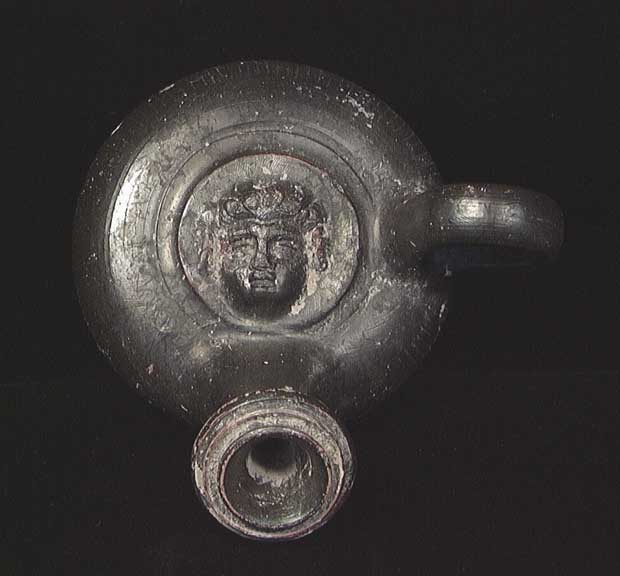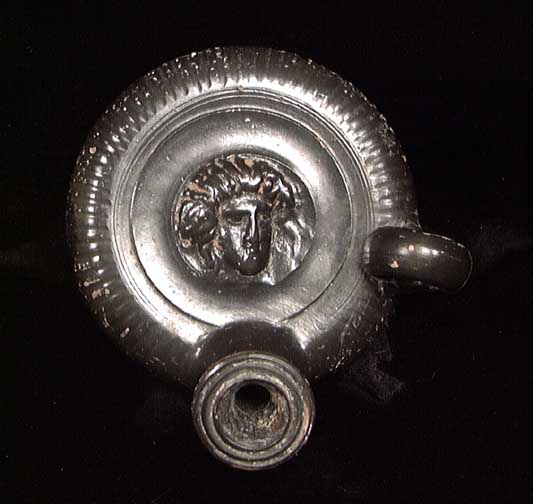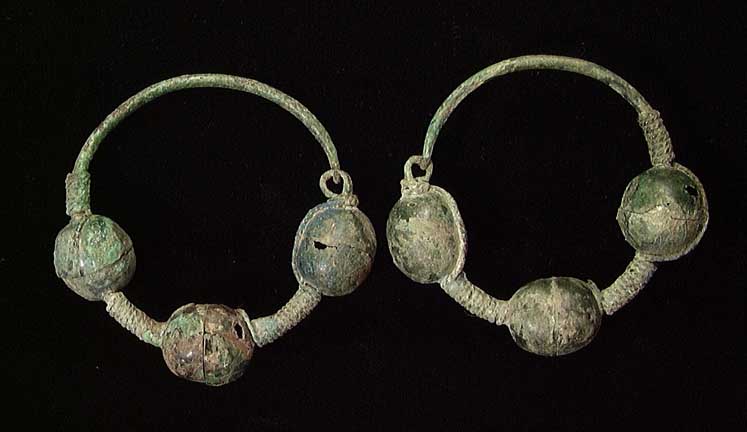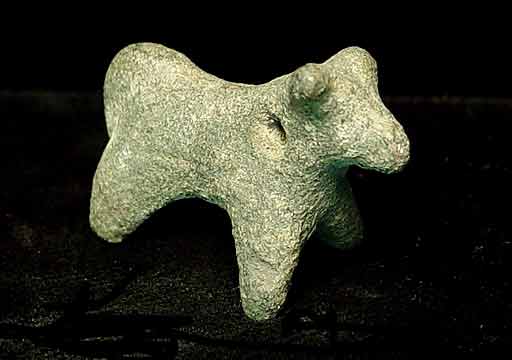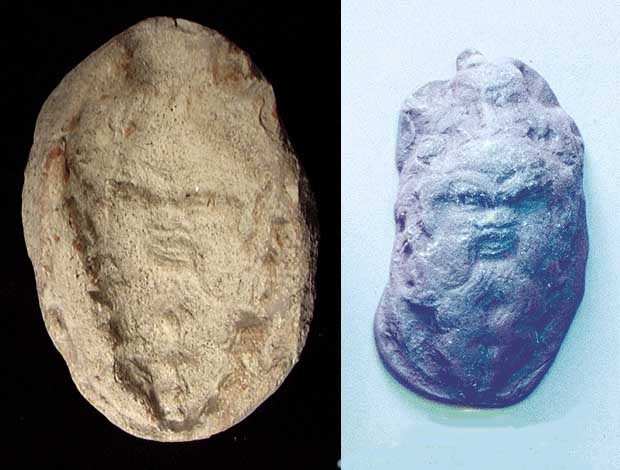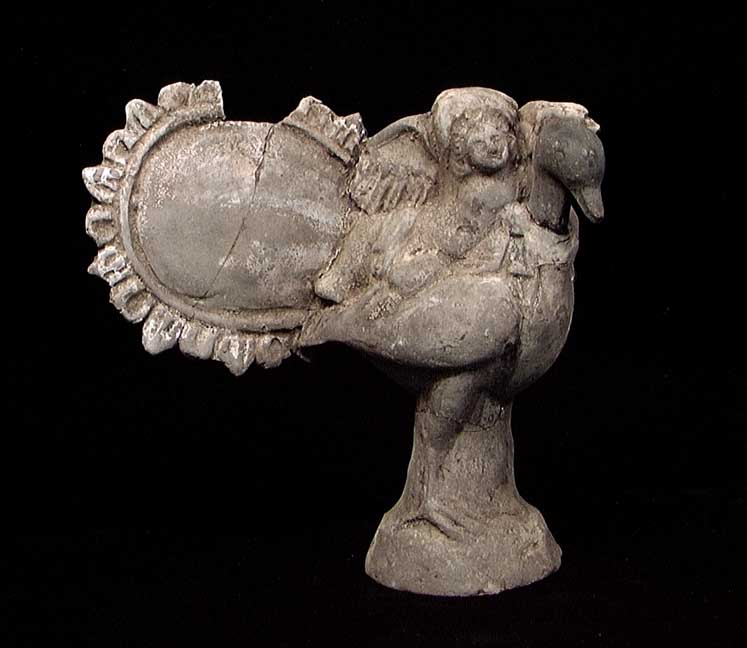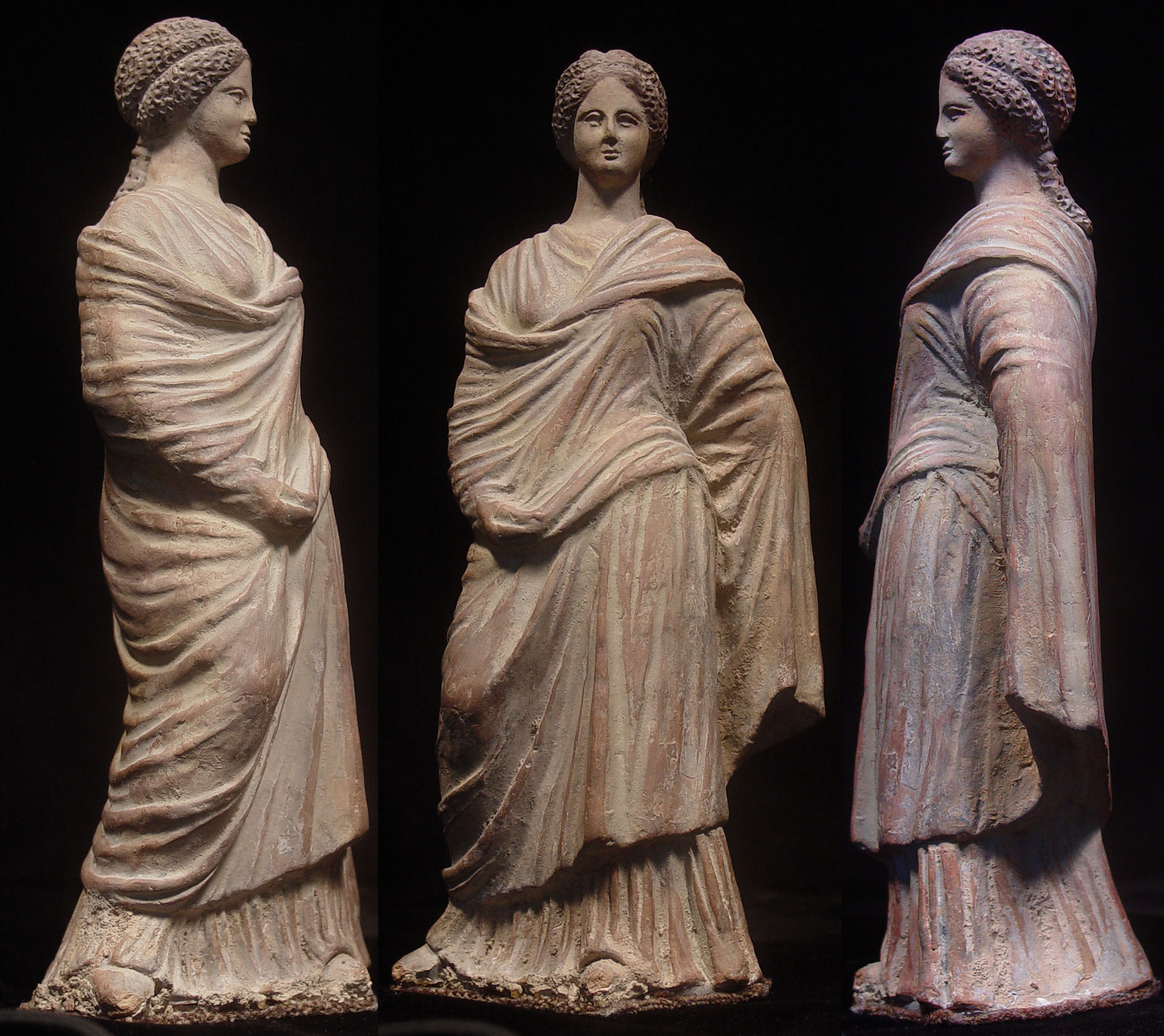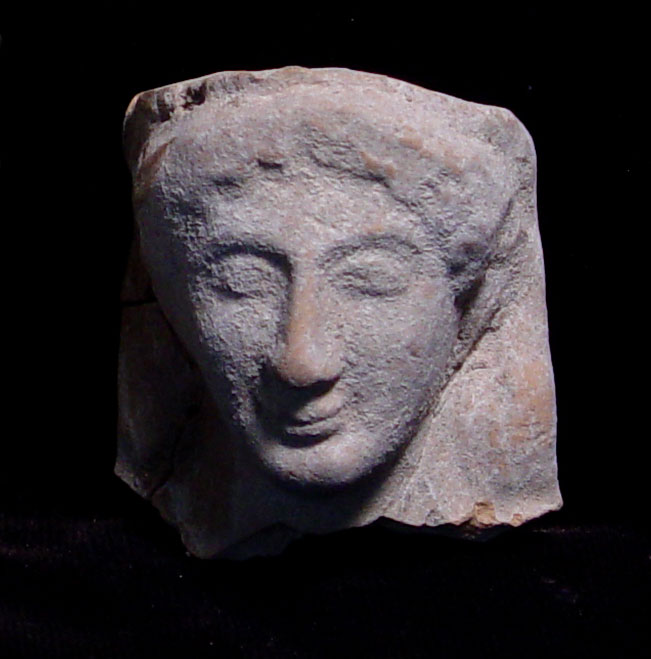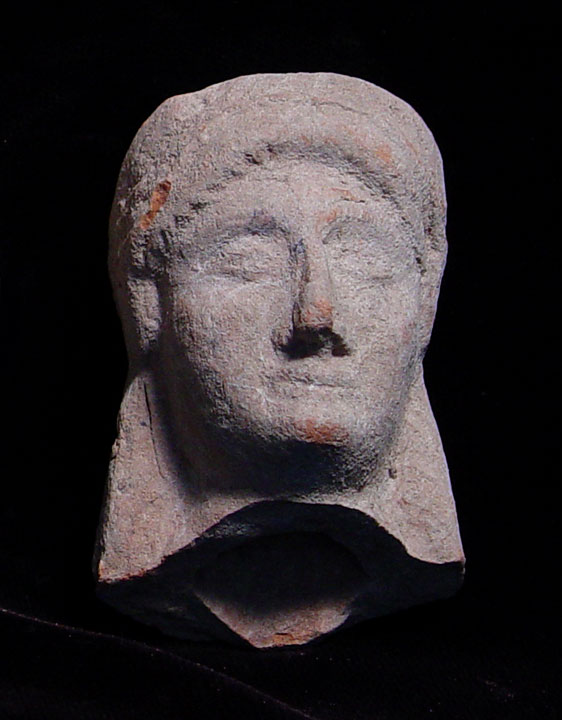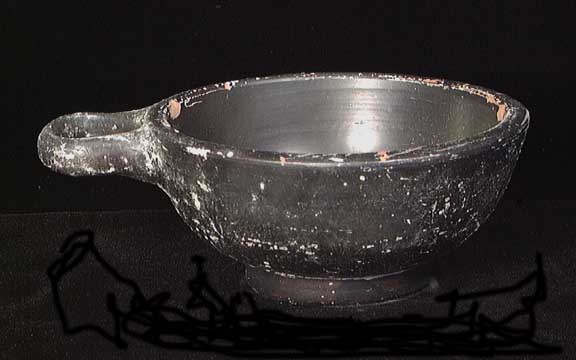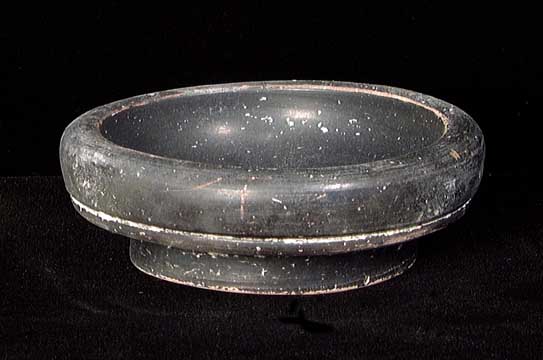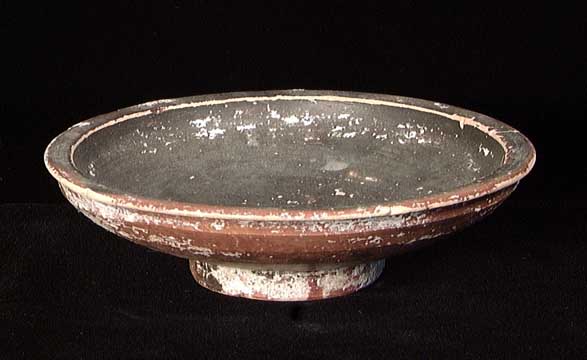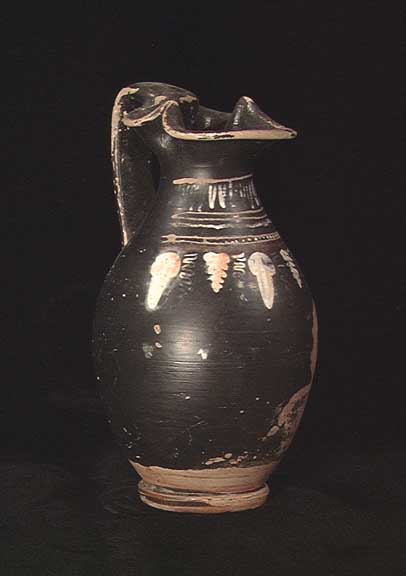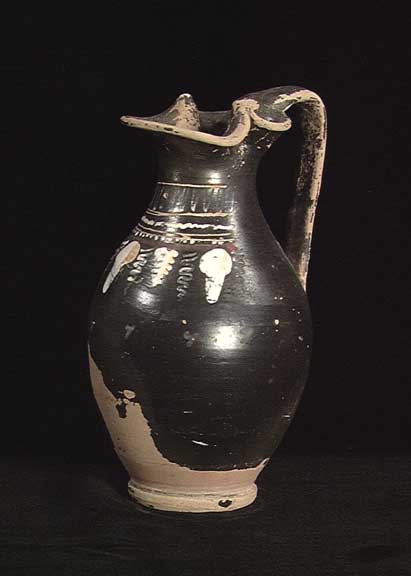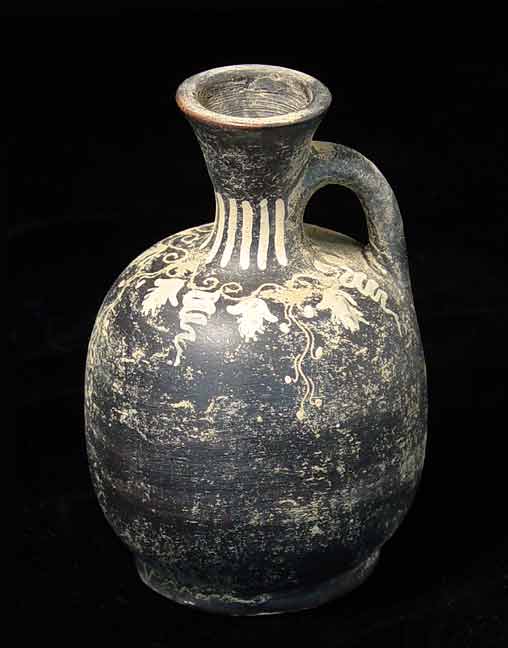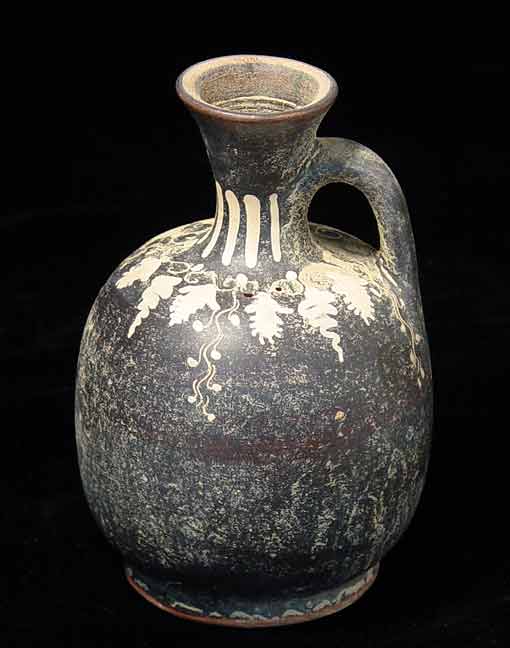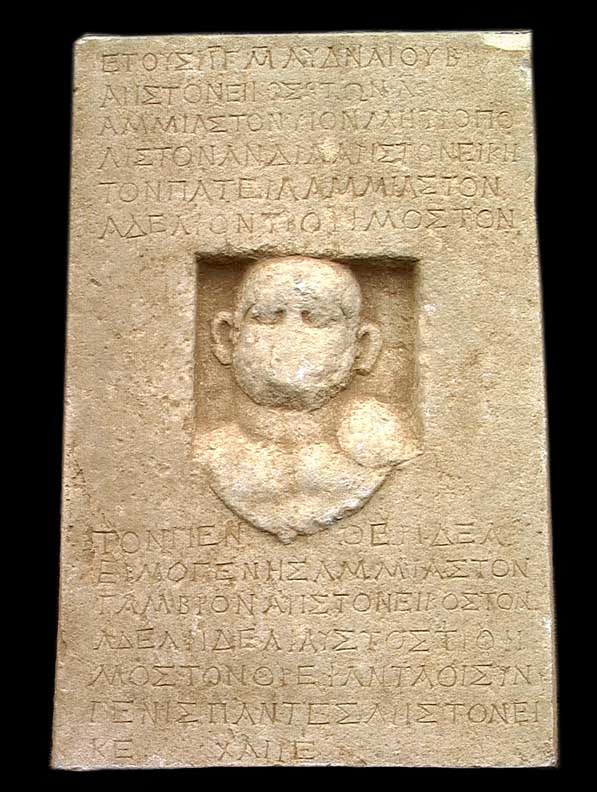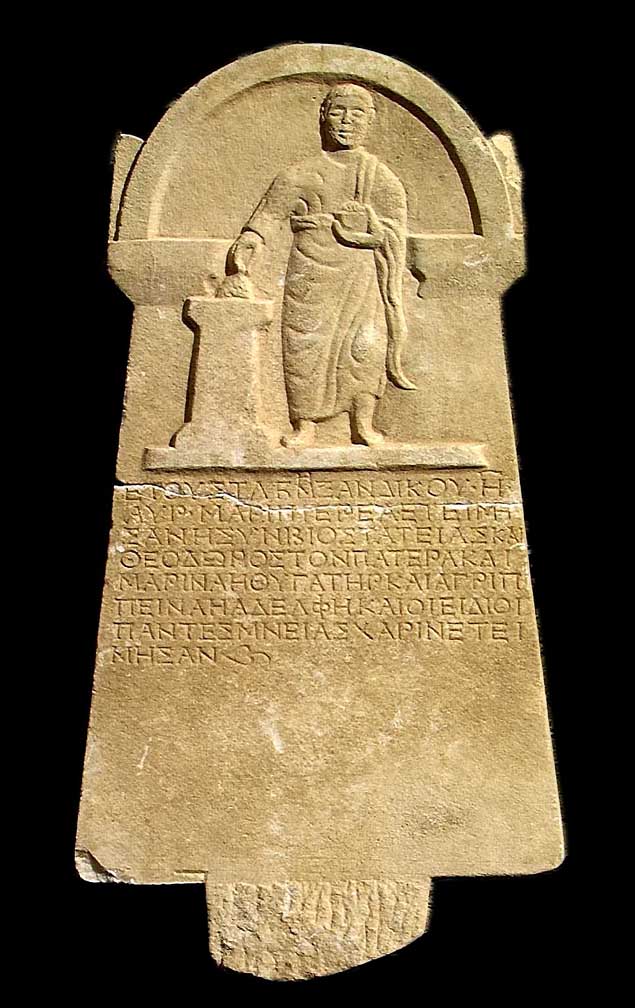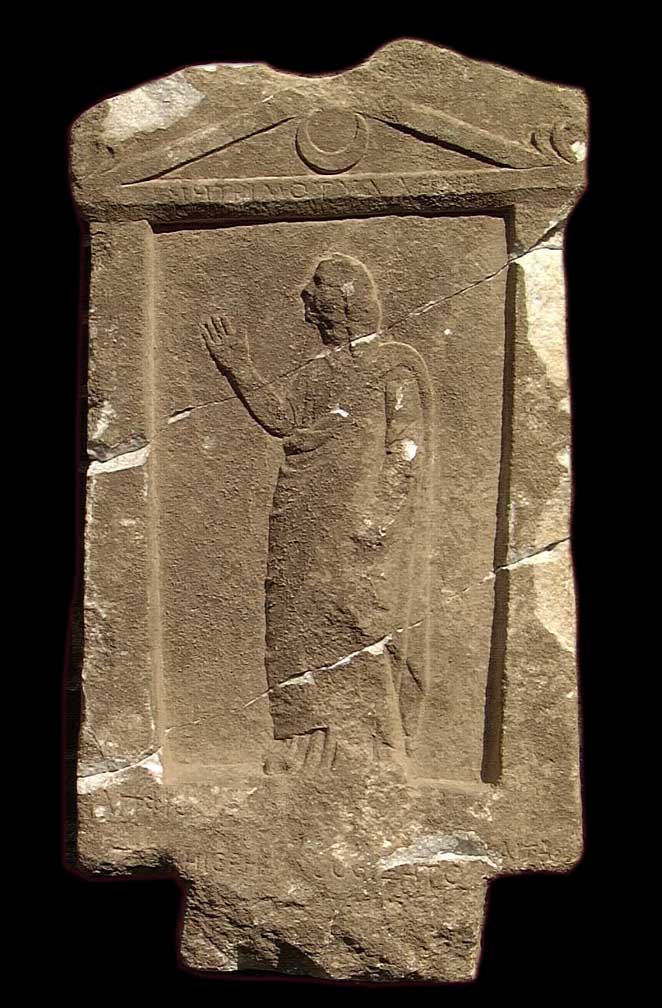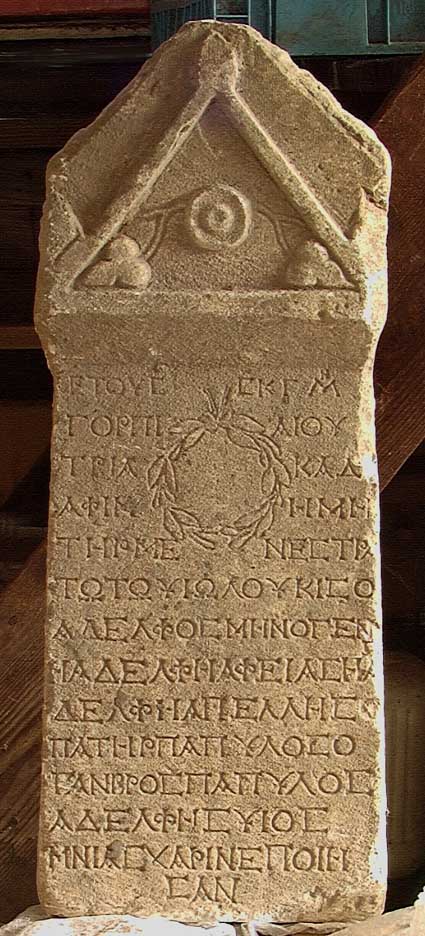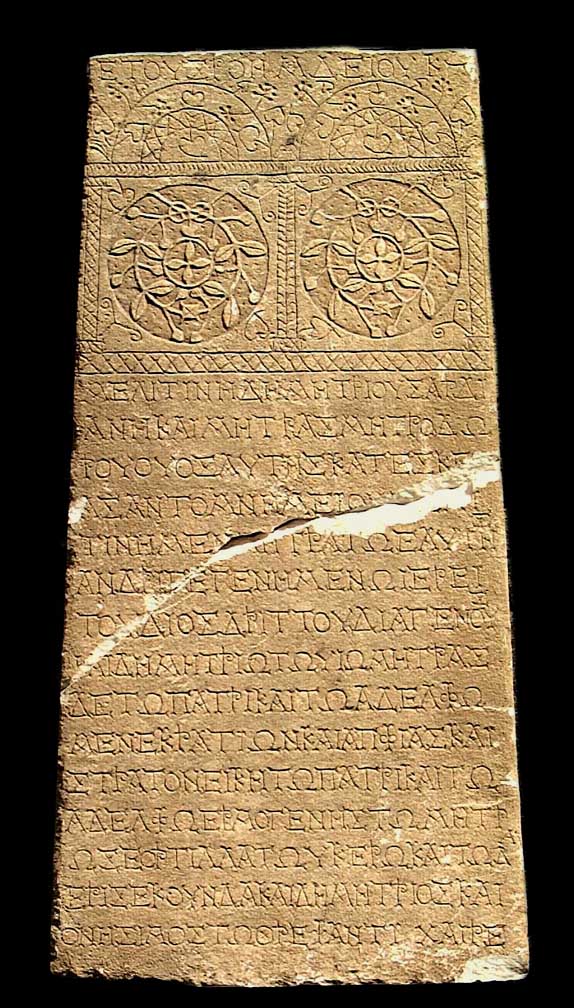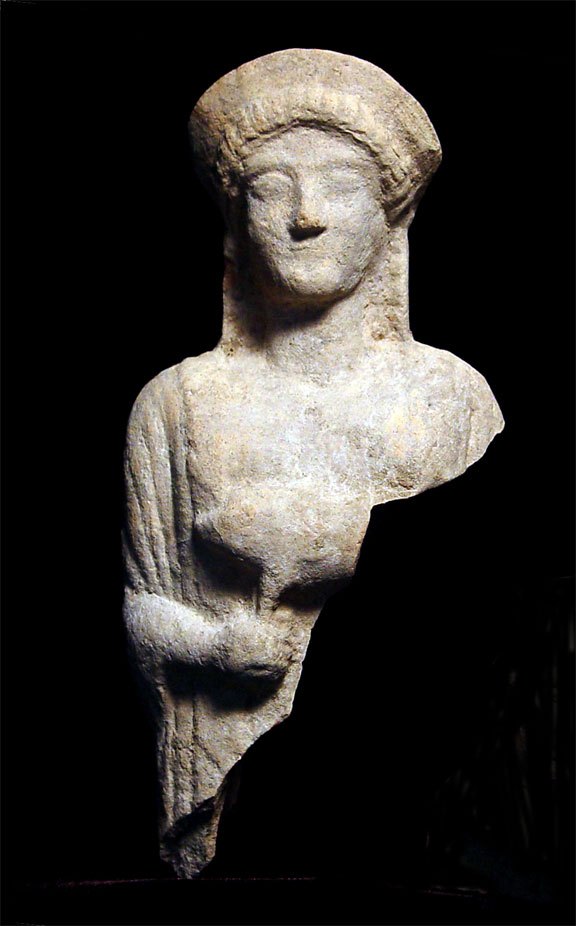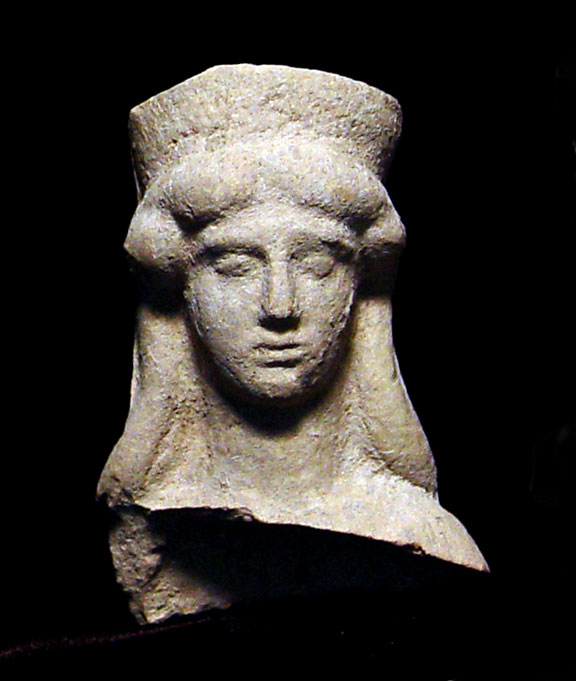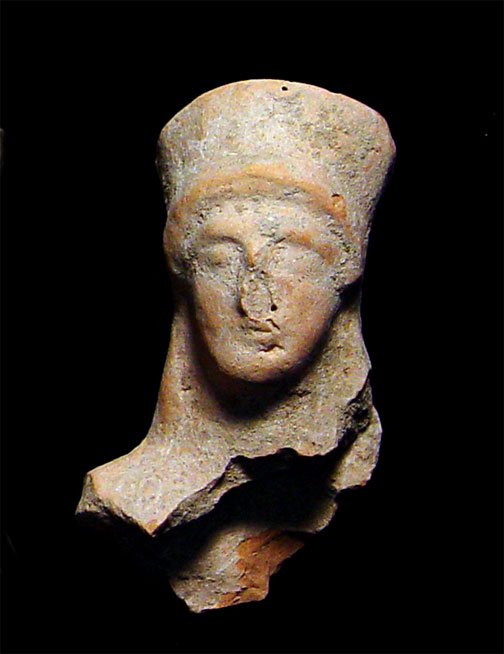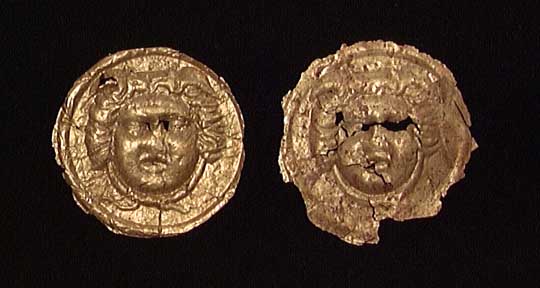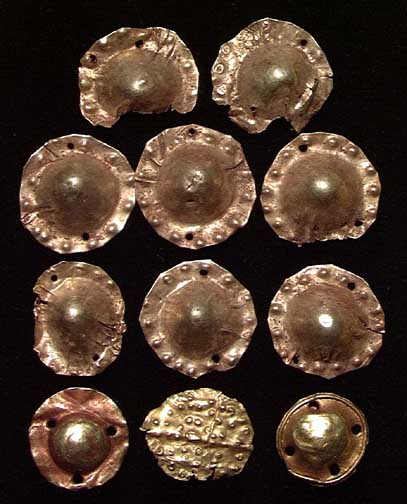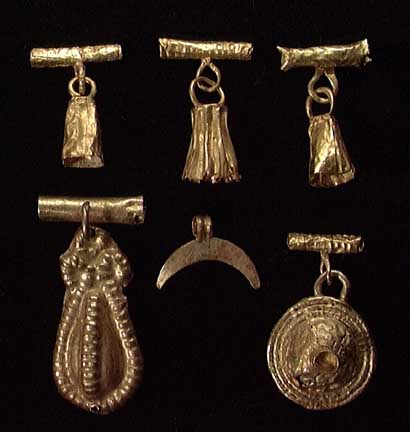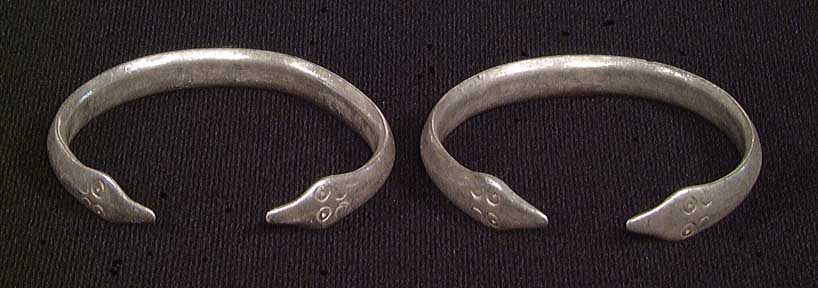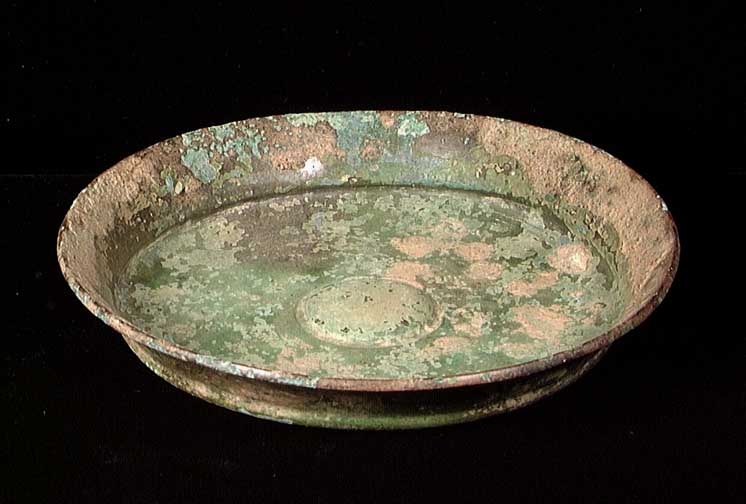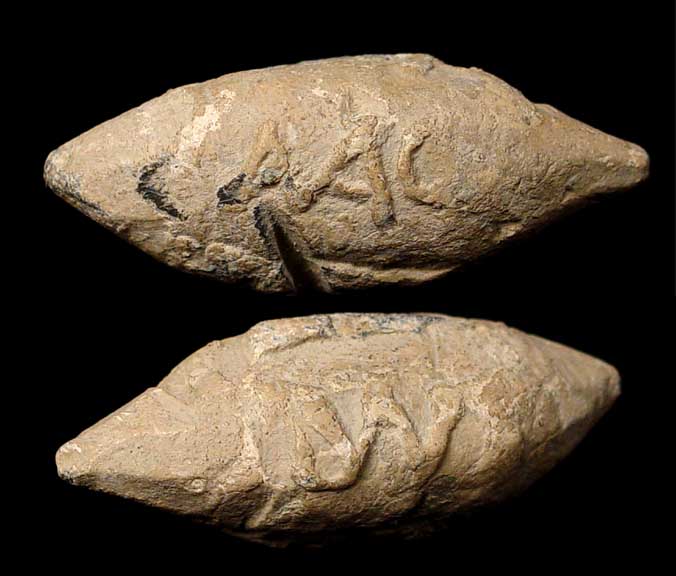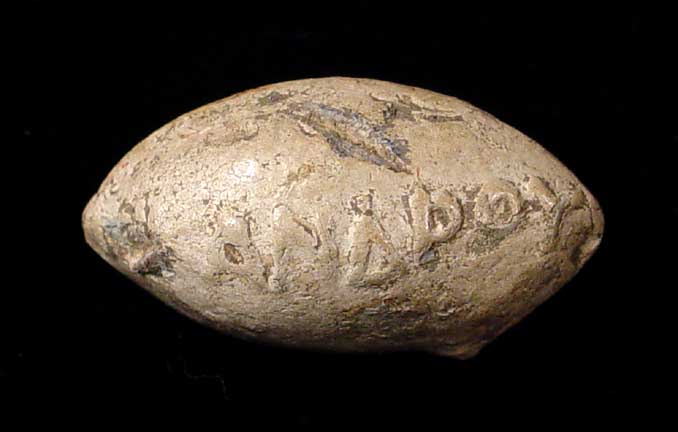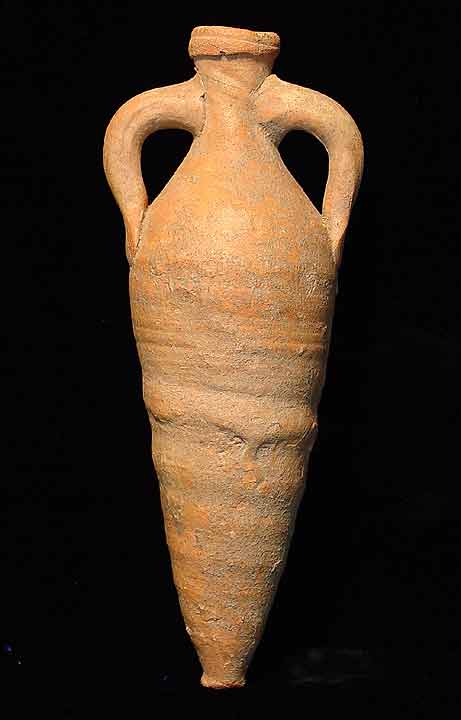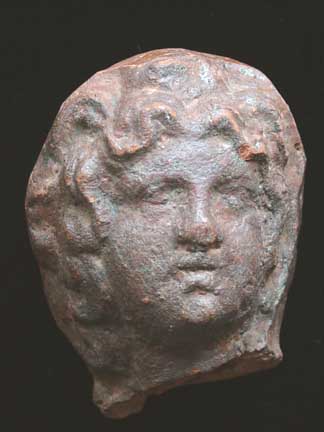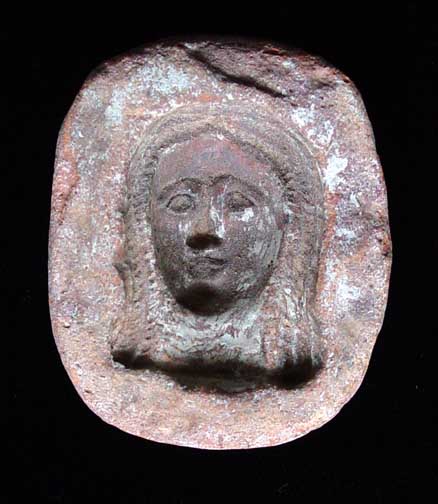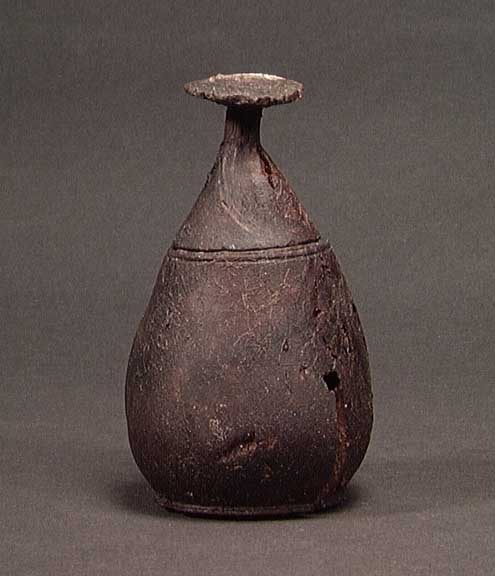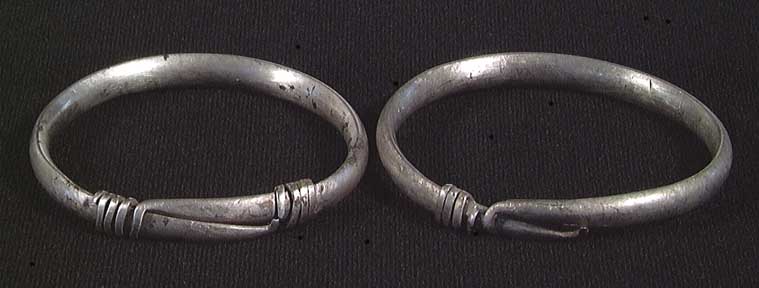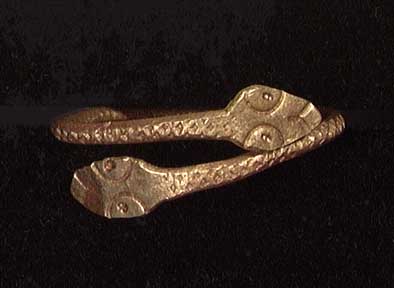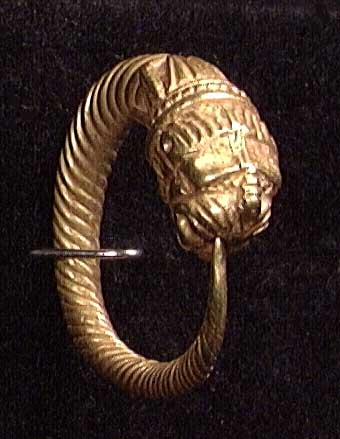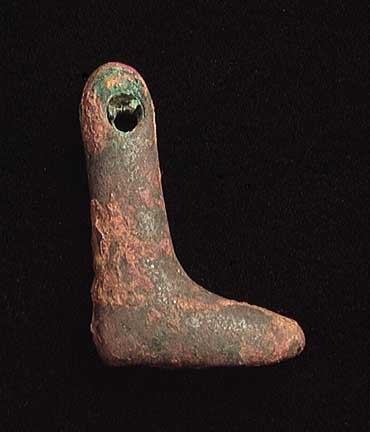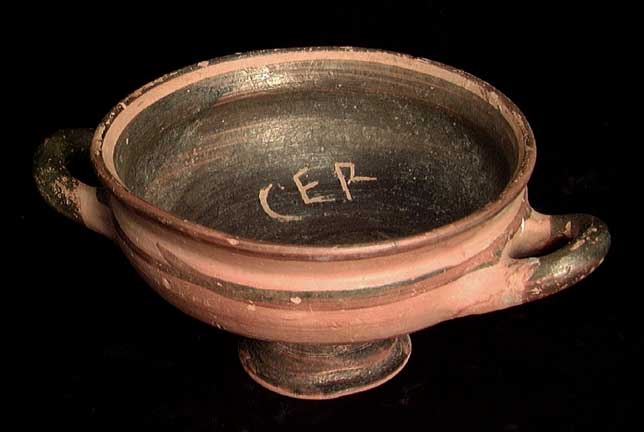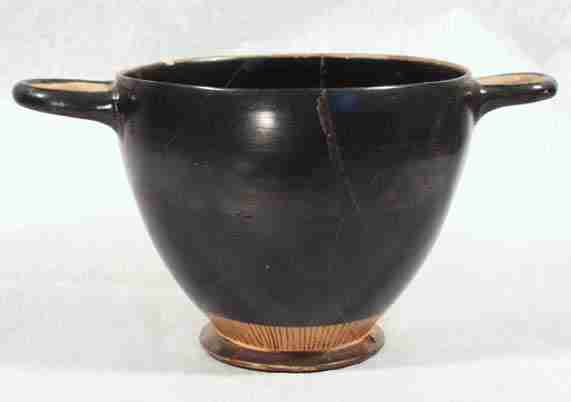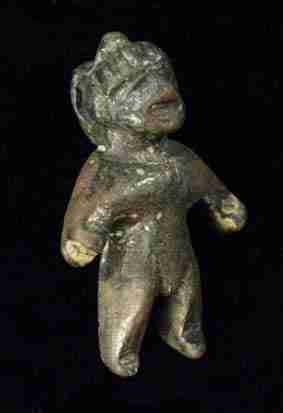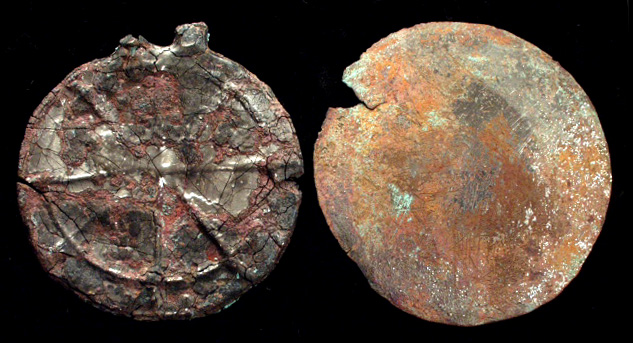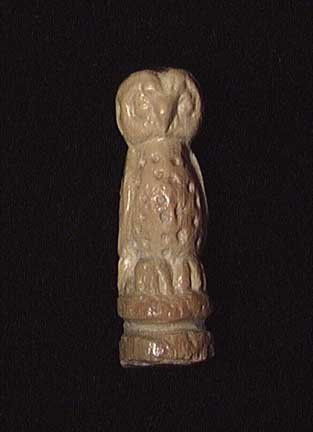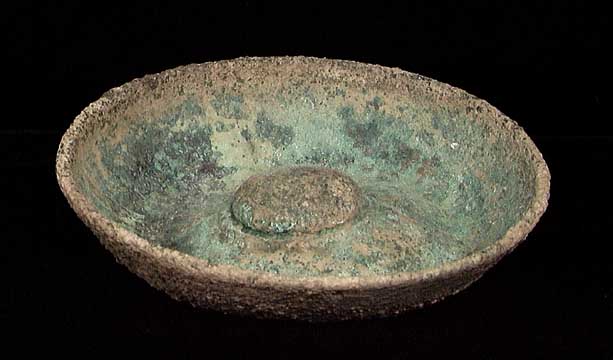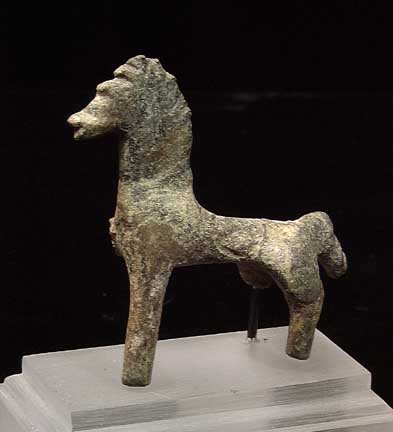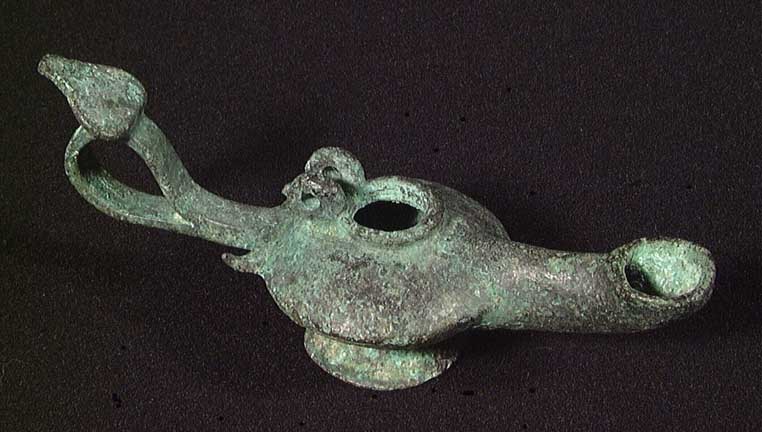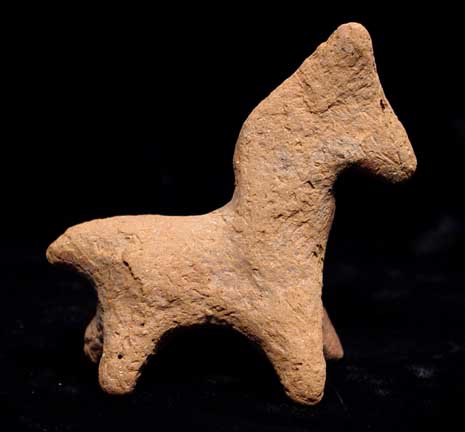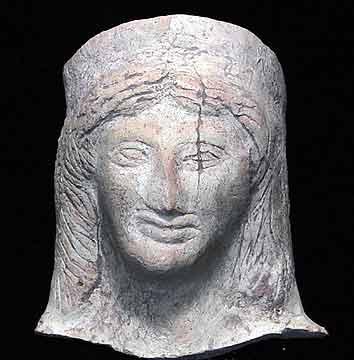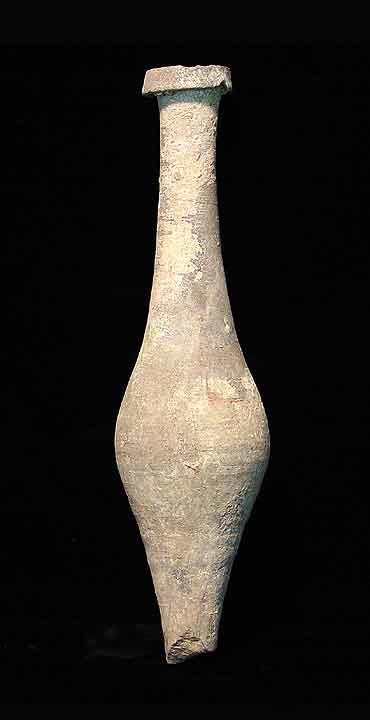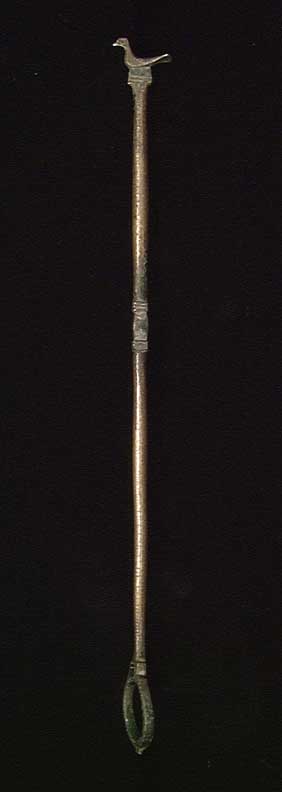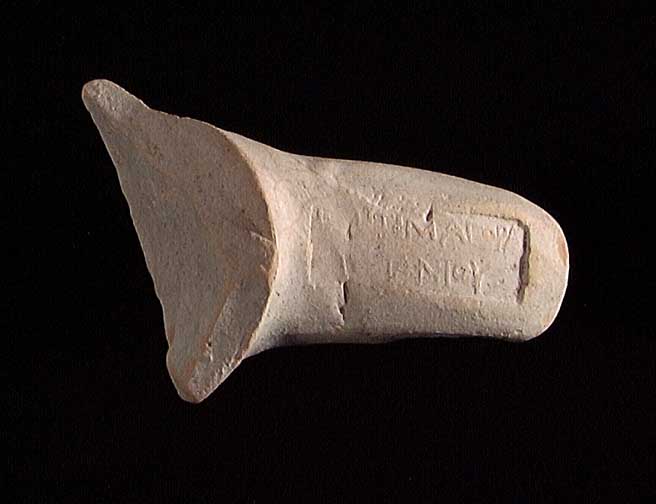SOLD ITEMS
CLICK GALLERIES AT LEFT FOR CURRENT INVENTORY
8281. A HELLENISTIC BRONZE BOWL, c. 3rd-5th century BC. Of hemispherical form with everted rim. 5.4". Intact.
8005. FINE GREEK BLACK GLAZED PYXIS, c. 4th-3rd century BC. The lidded vessel of elegant form with delicate knob handle on lid. 3.5 x 3.5 inches. Choice intact condition.
8006. RARE AND FINE GREEK BLACK GLAZED PYXIS, c. 4th-3rd century BC. The lidded vessel of elegant form with delicate knob handle on lid. 3 x 3.5 inches. Choice intact condition.
8279. A GREEK BRONZE AMPHORA, c. 4th-2nd century BC. The footed vessel with high neck with incised bands and flaring rim. Nice patina under deposits, a few cracks but still nice. 9". Very rare.
8690. HELLENISTIC BRONZE VASE, c. 3rd-1st century BC. Of elegant piriform shape with ring base and expanded rim. 4.5 x 6.5 inches. Excellent condition.
RARE GREEK INSCRIPTION 11580. GREEK BRONZE VOTIVE PLAQUE WITH INSCRIPTION. C. 2nd to 4th centuries AD. Bronze Votive Dedication Plaque. Cast slightly curved bronze dedication plaque with simple stepped base, inscribed [...]ΛA.../ΛIKAwN KE MA/PTIAΛIC EYΞAM/ENOI ANEΘEK/EYTOIXwC ([(For)...] Likaon and Martialis, having made a vow, set up [this] with good fortune). Dimensions: 92mm wide overall; 53mm high at highest point; 4mm wide at side edge (7mm at base), diminishing to 2mm thick across plate. Overall weight is 96.80 g. Holes for mounting on a statue base or cippus located at base of plate on either side. Upper portion of plate, which name the dedicatee in full, separated in antiquity; plate also punctured in antiquity. Cf. (for a Classical Greek example); cf. (for a bronze tabula ansata in Latin). Good condition, green and red patina, upper portion broken and lost in antiquity, evidence of puncture in antiquity. Provenance: Acquired at an American East Coast auction house. Enlargement. Back view.
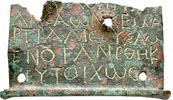
6791. A RARE GREEK BRONZE HANDLE WITH TWO INSCRIPTIONS, c. 3rd-1st century BC. The ornate handle with two inscriptions reading VΛIIIΓ and ΠAXΩΔN, the inscriptions quite clear. 5 inches. Rare!
9032. FINE GREEK TRANSPORT AMPHORA HANDLE. Rhodes, c. 3rd-2nd century BC. With rectangular stamp containing the radiate head of Helios and Greek inscription. 4 inches. On sale at: $450.
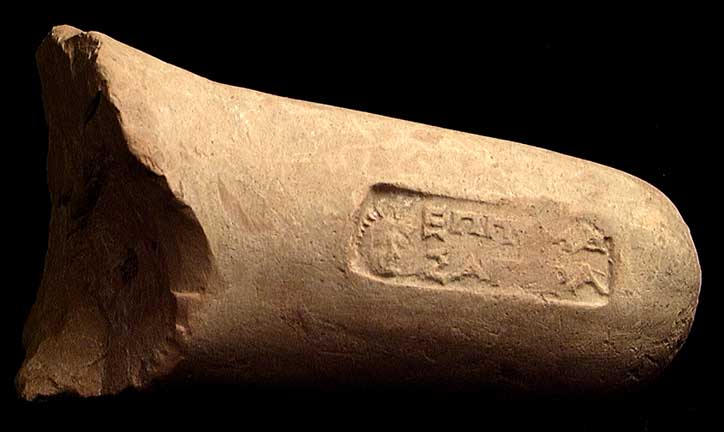
THE RHODIAN ROSE 9034. GREEK TRANSPORT AMPHORA HANDLE FROM RHODES, c. 3rd-2nd century BC. With circular stamp with the Rhodian rose and Greek inscription around. 3.75 inches.
On sale at: $350.
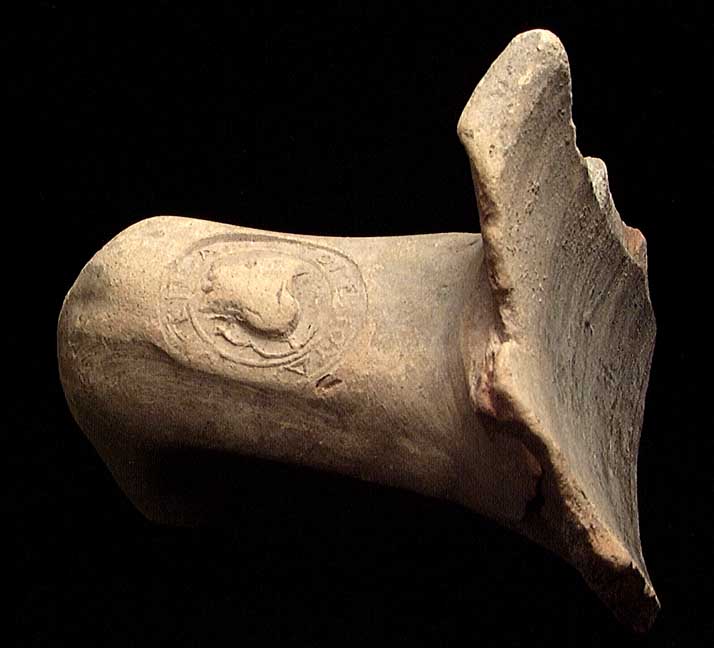
8284. A GREEK BRONZE INTAGLIO RING, c. 4th-3rd century BC. Finely carved with a rampant goat. 24mm. Excellent condition and detail. A fine quality classical Greek engraving. SOLD.
THE RHODIAN ROSE 9035.GREEK TRANSPORT AMPHORA HANDLE FROM RHODES, c. 3rd-2nd century BC. With circular stamp with the Rhodian rose and lengthy Greek inscription around. 2.4 inches. Enlargement.
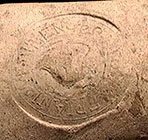
13070. GREEK MARBLE MEMORIAL STELE WITH OXEN. 2nd century BC - AD. The stele of trapezoidal form with mounting tenon at base, a section of the top missing. Carved with two panels of four and two oxen respectively, 6 lines of Greek inscription below. 17 x 13 x 1.5 inches. Likely a memorial erected to commemorate the founding of a new Greek or Eastern Roman settlement. A rare original Greek marble stele. Back view. Provenance: A private American collection. Purchased from a US antiquities dealer in 1999.

7995. HELLENISTIC PIRIFORM ARYBALLOS, c. 3rd-2nd century BC. Twin faux handles make this an especially rare type. 7.5 inches. Free standing. Choice intact condition.
6202. SCYTHIAN BRONZE APPLIQUE. Steppes area, c. 1st millennium BC. The applique in the form of an ibex with arched back. 1.5 x 1.75 inches. A nice example of the Central Asian animal art style.
6770. GREEK BLACK-GLAZED BOWL WITH ROSETTES, c. 4th century BC. On high base with impressed palmette designs. 5.5". Tiny age line otherwise intact. Old collection number on base.
6762. RARE ATTIC GREEK RED FIGURE OINOCHOE, c. 4th century BC. Painted with the head of a young satyr. 4.2". Minor repair to rim.
7595. A LARGE CANOSAN GREEK FUNERARY OINOCHOE, c. 3rd century BC. At the base the finely modeled head of a lady or goddess with laurel leaf wreath. Above on a broad strap handle, the molded figure of an elegant lady wearing hat and cloak. Considerable white slip remaining with slight traces of pink and blue. Intact and very rare this type of vessel was made for the tomb without an enclosed bottom and not intended for daily use. Height: 14.2". Right side. Back. Left side. Front. Top figure enlargement. Provenance: Purchased from Harmer Rooke Galleries in the 1980s or '90s. Documented proof it's been in the US since at least Mar 16, 1998, and separate 3rd party documentation from Dec 1, 1998. This is well before the US MOU with Greece from 2011, and Italy from Jan 19, 2001 which restrict import of archaeological items after those dates. This clearly establishes the legality of the piece.
9654. A GREEK RED FIGURE LEKYTHOS, ca. 4th century BC. The tall necked vessel with the head of a fashionable lady flanked by palmettes. 6 inches. Small firing line behind head. 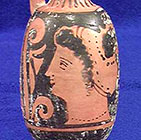
6764. A GREEK RED FIGURED SKYPHOS, c. 4th c. BC. With Eros holding a mirror on one side, a lady with a mirror on the other. 4.3"h. Stable line in rim. Exceptionally fine style.
6763. CLASSIC GREEK RED FIGURE OWL CUP, c. 4th cent BC. Painted with owls and laurels both sides. 5.5" across handles.
9677. A GREEK RED FIGURE LEKANIS, c. 4th c. BC. With the heads of fashionable ladies & palmettes. 3.8". Chip on foot restored else intact. 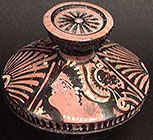

9637. A FINE DAUNIAN GREEK SKYPHOS, ca. 3rd century BC. The buff-ware two-handled wine cup with slate black and red. 4.5 x 5.25 inches across handles. Intact and in excellent condition. 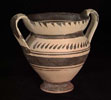
7592. A LARGE ARCHAIC GREEK TERRA COTTA GODDESS, c. 6th century BC. The terra cotta figure of a seated goddess or Kore. Very rare this large. Minor repair to base. Height: 13".
9685. CLASSIC ATTIC RED FIGURE LEKYTHOS, c. 5th century BC. The vessel with a standing female gesturing expressively to the right. 5.5 inches. Rim chip reattached, otherwise intact. 
8124. RARE ATTIC RED FIGURED LEKYTHOS WITH A SPHINX, c. 425-400 BC. The small lekythos with a finely painted sphinx, egg and dart pattern on shoulder. 3.6 inches. Choice and intact.
6765. ATTIC GREEK RED FIGURE SQUAT LEKYTHOS, ca. 4th century BC. Head of a lady with her hair in a sakkos. 4.5". From an old European collection. Neck reattached.
AN EXQUISITE EXAMPLE OF ANCIENT GREEK GOLD WORK 13016. VERY FINELY DETAILED GREEK GOLD ORNAMENT. Greece, c. 4th-3rd century BC. A wonderful floral ornament only 10 x 14 mm but showing the incurable fine detail of gold smithing the finest ancient Greek artisans were capable of. In the middle of the figure eight ornament sits a small 6 petalled flower, and the gold wire bordering the petals is granulated with hundreds of beads down to an incredible 0.1 mm scale invisible to the naked eye. Obvious proof that the Greek jewelers worked with high quality magnifying lenses. A miniature masterpiece likely nearly impossible to recreate even today. The reverse has a ~1 mm diameter mounting sheath of folded 0.1 mm gold that would have fitted over a gold wire for mounting. Another view. Reverse.
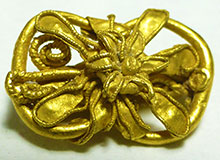
8243. A RARE ARCHAIC GREEK MOTHER AND CHILD STATUETTE, c. 6th-5th century BC. Typical archaic goddess or kore otherwise but the only one I've carried holding a child. 7". Minor chips. Extremely rare.
7978. LARGE ARCHAIC GREEK GODDESS HEAD, c. 6th century BC. Wearing high polos. 3.75 inches. Rare with good features.
9635. A DAUNIAN GREEK PEDESTAL PLATE, ca. 3rd century BC. The buff-ware plate on pedestal base with concentric rings of brown glaze. 3.3 x 6.5 inches. Intact. Scarce type. SOLD.
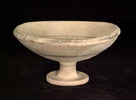
9688. SCARCE DAUNIAN GREEK ASKOS, c. 4th-3rd century BC. Black glazed designs on cream ground. 5". Nice condition and rare. SOLD.
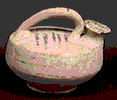
8255. A GREEK RED FIGURE LEKYTHOS, c. 4th century. BC. Painted with a scene of Eros seated on a rock holding a jewel box. Repair with a little repainting in the fields. 7".
11525. HELLENISTIC GREEK GOLD RING. 3rd-2nd century BC. Side view. Provenance: A London collection. Good and legal provenance provided to buyer.

12912. GREEK BRONZE PITCHER. Eastern Mediterranean, 3rd-1st century BC. 7 inches. Fine glossy black patina with touches of green. Other side. Provenance: The property of a European gentleman. Handle. Top.

12905. GREEK BRONZE BOWL. Eastern Mediterranean, c. 4th-3rd century BC. 4.75 x 2 inches. Small rim crack, pretty multicolor patina. On custom plexiglas stand. Provenance: The property of a European gentleman. Reverse. Side view. Top view.
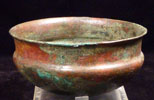
11507. A FINE MACEDONIAN GREEK SILVER PHIALE OMPHALOS, 3rd century BC., Silver and in excellent condition. 15 cm. diameter. Provenance: Good and legal provenance provided to buyer. From an old Belgian collection since the 1960's with papers. Bottom view. Close up.
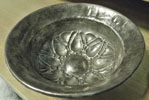
11522. LARGE GREEK TERRACOTTA BUST. 3rd century BC. 30 cm high x 26 cm wide x 12 cm deep. In original condition with some encrustation and remains of white slip. Slight chip to nose and around base rim and some restoration. Full view. Provenance: A London collection. Good and legal provenance provided to buyer.

EXCEPTIONAL CONDITION 11510. A VERY RARE GREEK IRON SWORD. 6th century BC. 61 cm length. An exceptional intact example. Ancient iron is rarely preserved this well. Provenance: Good and legal provenance provided to buyer. From an old Belgian collection dating to the 1960's. Full length side A. Full length sideB. Hilt.

11515. A VERY RARE GREEK IRON SWORD. Northern Greece. Late 8th century BC. 60 cm length. An exceptional intact example after a Bronze Age type. Ancient iron is rarely preserved this well. Provenance: Good and legal provenance provided to buyer. From an old Belgian collection dating to the 1960's. Full length side A. Full length side B.
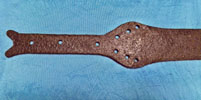
AN UNUSUAL FORM 13007. ROOSTER VESSEL. Mesopotamia, c. mid 1st millennium BC. The ceramic vessel in the form of a rooster, the face and comb in red slip over white body, a central filling hole with two strap handles, the beak opening into a small spout. 12 x `12 x 6 inches. Small hole in breast, chips to wattles and reattached at neck, otherwise complete in nice condition with all original paint. Provenance: An extensive North Eastern collection. Left side. Oblique back. Oblique front. Close up.
SOLD.

RARE MATCHING PAIR 13008. TWO GREEK ANTEFIXES. Greece, c. 3rd-2nd century BC. The hard fired ceramic antefixes with busts of Hermes wearing his winged hat, pairs of grain ears and spirals below. 6 x 10 x 7.5 inches. One top lug reattached, otherwise complete in excellent condition with no repair or restoration. Provenance: An extensive North Eastern collection. Left side. Right side. Backs. Bottoms.
SOLD.
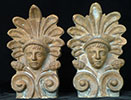
11105. CAMPANIAN GREEK RED FIGURE BELL KRATER. 11" height, very nice condition. SOLD.
7999. HELLENISTIC PIRIFORM ARYBALLOS, c. 3rd-2nd century BC. 7 inches. Free standing. SOLD.
8239. VERY RARE GREEK AMBER CARVING OF THE HEAD OF A SILENOS, c. 6th century BC. The amber nugget carved into the head of a Silenos facing left with long beard. 2.6". Ancient patina with chip at top showing dark red amber, the remainder with natural ancient patina. The reverse uncarved. All Greek amber is excessively rare. Cf. Christie's Dec. 1998, #76-79 for similar pieces probably cleaned estimated from $3000-$15,000, including a very similar one to the present example estimated at $10,000-$15,000. SOLD.
8240. VERY RARE GREEK AMBER CARVING OF A RAM'S HEAD, c. 6th century BC. The amber nugget carved into the head of a ram with long curled horns. 2.1". With natural ancient patina, tiny chip showing dark red amber. The reverse uncarved. All Greek amber is excessively rare. Cf. Christie's Dec. 1998, #76-79 for similar pieces probably cleaned estimated from $3000-$15,000. SOLD.
8241. VERY RARE GREEK AMBER CARVING OF A RAM, c. 5th century BC. The amber nugget carved into the head of a ram in the round. The reverse. A full three dimensional head carved on both sides. 1.8". Natural ancient patina with chip at neck showing dark red amber. All Greek amber is excessively rare. Cf. Christie's Dec. 1998, #76-79 for similar pieces probably cleaned estimated from $3000-$15,000. SOLD.
6290. A HAND COLORED STEEL ENGRAVING OF THE RUINS OF THYATIRA, 19th century. Depicting ancient Greek ruins in Turkey. 5 x 7 inches for the image itself. SOLD.
7989. GREEK BRONZE HIPPOCAMP, c. 3rd-1st century BC. Winged horse with tail of a fish as seen on Greek coins. Detail both sides. 1.5 inches. Rare and nice. SOLD.
CONFIRMED GENUINE BY CHRISTIE'S AND TIMELINE 11471. A GREEK SILVER PHIALE. c. 5th-4th century BC. 4.5 inches diameter. The silver offering bowl with central omphalos surrounded by raised beads, hatches and multiple petals in repousse technique. Provenance: In an important collection of antiquities in the Netherlands since the 1970's. Inside view. Bottom view.
SOLD.

7310. GREEK TERRA COTTA HEAD OF A BOY, c. 3rd-1st century BC. Handsome finely modeled face with pudgy features of youth. 1.75 inches. Excellent quality. SOLD.
8242. A GREEK MARBLE STELE, c. 4th-1st century BC. Carved with the figure of the god Hermes holding a purse and caduceus. 8". SOLD.
12932. A GREEK MARBLE LADY. 3rd-1st century BC. A fine classical marble figure of a Greek lady wearing a shorter outer himation over a full length chiton which falls to her feet. Intact other than the head, mortise holes in arms for hands which would have been made separately. 15 inches (38 c.) Free standing. Provenance: The property of a European gentleman. Back view.
SOLD.

7992. GREEK LEAD SLING BULLET WITH INSCRIPTION. Sicily, c. 1st century BC. Molded midridge and Greek inscription LAXYE, impact mark on rv. 3 cm. Attribution of the inscription appreciated. SOLD.
6751. A FINE MACEDONIAN BRONZE HELMET. Illyrian type, c. 6th century BC. Hammered from a single sheet of bronze, with twin reinforcing ridges on the top and two long pointed cheekpieces. Fine engraved decorative edging. 9.6 x 11.5". Professional repair in crown area & left cheekpiece which is bent inward a bit with a bit of edge missing. See Sothebys #LN5697 lot 113 for a very similar example. An exceptional example in the quality of its wonderful glossy green patina which covers the entire helmet. Extremely rare. Comes with a custom stand. This helmet style is usually described as Illyrian in the literature but they were also worn by the Macedonian kings as they are also found in the royal tombs at the Macedonian capital of Pella. Click here for a helmet identical in style recently found at Pella. Left side view. Top view. Front view SOLD.
9653. ATTIC GREEK RED FIGURE LEKYTHOS, ca. 5th century BC. The vessel with a laurel wreath band in black figure technique around the shoulder. 4.8 inches. Intact with minor deposits. SOLD.

9683. SOUTH ITALIAN MASTOID CUP, c. 5th century BC. The cup with distinctively upturned handles, remains of glaze on upper half. 3.25". Rare form. SOLD.

8703. GREEK BLACK-GLAZED CUP, c. 4th century BC. Nicely turned with pedestal base. 2 x 3.1 inches. Intact. SOLD.
8704. A SMALL GREEK BLACK-GLAZED DISH, c. 4th century BC. With decoratively incised rim on pedestal base. 1.1 x 2.5 inches. Intact with areas of silvery iridescence on the interior. SOLD.
8001. ATTIC BLACK GLAZE LEKYTHOS, c. 6th-4th century BC. Dot and line pattern on shoulder and Greek key band. Some flakes but still nice. 5 inches. Other side. SOLD.
6776. A CALENE WARE RIBBED VESSEL, c. 3rd c. BC. The finely formed vessel with added design in yellow and red. 4.2". Rare and intact. Considerably better than image shows. SOLD.
8274. A CALENE WARE GUTTOS OIL LAMP FILLER, c. 3rd century BC. Fine intact black glaze lamp filler with molded Dionysos head on the discus. 4.5". SOLD.
6774. A CALENE WARE GUTTOS OIL LAMP FILLER, c. 3rd c. BC. With molded facing head of Apollo. 4.3 x 3". Intact. SOLD.
7990. RARE GEOMETRIC PERIOD GREEK BRONZE BULL, c. 900 - 700 BC. Sub-geometric style bull with suspension hole. 1.1 inches. Scarce. Would make an excellent pendant! SOLD.
8250. GREEK TERRA COTTA MOLD OF A SILENOS, c. 5th-3rd century BC. The mold for producing a bushy bearded Silenos head. 3". Very rare. SOLD.
11164. TANAGRA GREEK FIGURE OF A VEILED LADY. c. 350 BC. Terracotta figure of a veiled woman standing, weight on her left leg, wearing chiton and himation arranged to veil her hair, her right hand clasping her himation at the neck, her left arm akimbo. Brown clay with considerable remains of white pigment. Intact. 8 inches in height. Collected in the early 1900's in Greece by the grandmother of the current elderly owner. Shown to the Victoria and Albert museum in 1987 which confirmed its authenticity. See a slightly larger similarly dressed and posed figure listed at Royal Athena for $12,500. 'Tanagras' are named after the site in Boeotia, central Greece, where thousands of similar figures were unearthed in the early 1870s. Figures of men, children and comic actors were also found at Tanagra, but standing female figures are the most numerous. The chief appeal of Tanagra figures lies in their exceptional artistic quality usually considered to be the finest of all Greek figurines. The ladies are normally depicted in casual poses and their clothes, which usually consist of a thinner undergarment, the chiton, worn beneath a thicker cloak or himation, are typically pulled and twisted in pleasing patterns which emphasize the form of the figure beneath. Most Tanagra figures are mould made and sometimes have a vent cut in the back to ensure even distribution of heat in the firing. After firing, the figure was coated in a white slip, often a solution of chalk or white clay, and then colors were added on top. The artists who produced these figures were known as coroplasts, literally 'modelers of girls'.
SOLD.
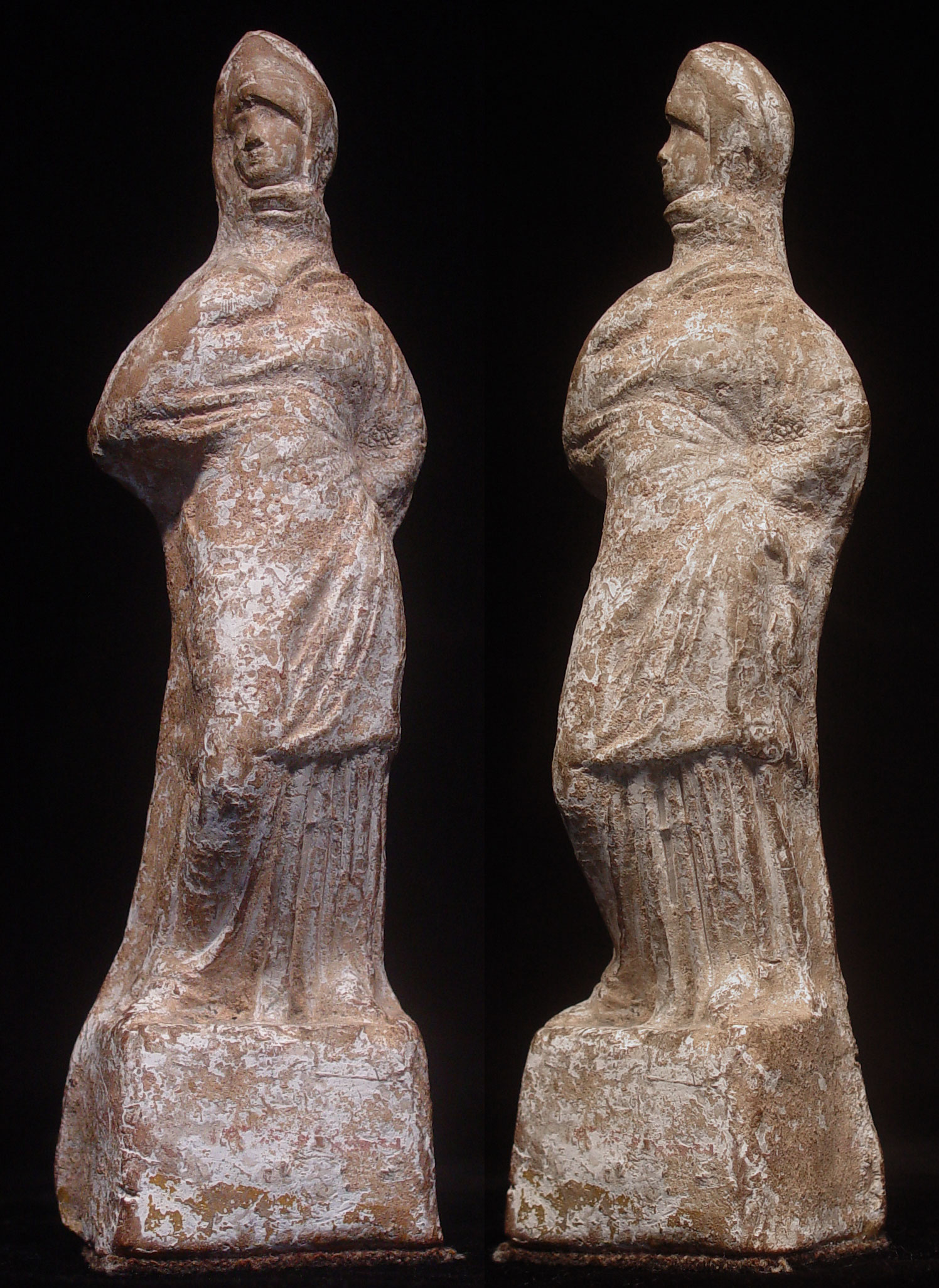
10087. AN ARCHAIC GREEK VOTIVE TERRA COTTA GODDESS. c. 4th century BC. The Korai style figure with long braided hair. 2 x 2.25 inches. Good example with good detail and remains of white pigment. SOLD.
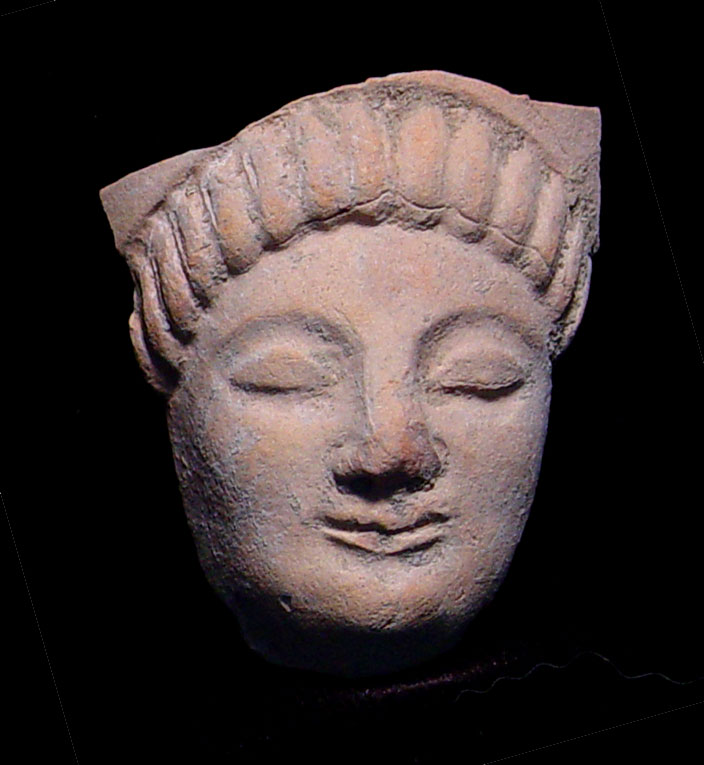
9678. CAMPANIAN BLACK GLAZED PLATTER, c. 4th c. BC. With pedestal base & black glaze with light abrasion. 5.7". SOLD.

6307. Scythian bronze pin, VI-IVc.BC, 4.2". SOLD.
8270. A CAMPANIAN ONE-HANDLED CUP, c. 4th century BC. The cup with ring base. 4.9" width across handle. Couple of small flakes. SOLD.
8266. A GREEK BLACK-GLAZED DISH, c. 4th century BC. On ring base with shallow bowl. 3.75". Intact. SOLD.
8267. A GREEK BLACK-GLAZED DISH, c. 4th century BC. On ring base with shallow bowl. 5.1". Intact. SOLD.
8119. GNATHIAN WARE BLACK GLAZED BOTTLE, Greeks in South Italy, c. 4th century BC. Grape vines in pale yellow on black glazed body. Light deposits. 3.25 x 5 inches. Intact. SOLD.
8121. GNATHIAN WARE BLACK GLAZED TREFOIL OINOCHOE, Greeks in South Itally, c. 4th century BC. Grape vines in pale yellow on black glazed body. Light deposits. 3 x 6.25 inches. Handle repaired. SOLD.
8701. A GNATHIAN WARE OLPE, ca. 4th century BC. The fine black glazed pot with ridged body and decorated with a band of yellow vines around the shoulder. 4.2". Intact. SOLD.
10085. AN ARCHAIC GREEK VOTIVE TERRA COTTA GODDESS. c. 4th century BC. The Korai style figure with long braided hair. 2 x 2.5 inches. Good example with good detail and remains of white pigment.
SOLD.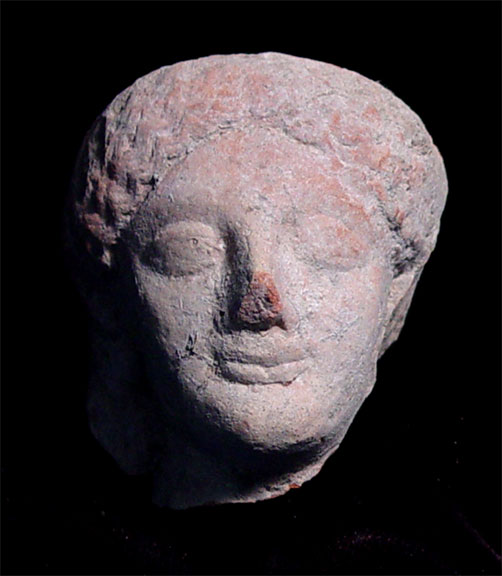
SOLD.
6445. 2 GREEK GOLD APPLICAES, c. 3rd-1st cent. BC. Matrix formed gold leaf facing heads of gods or goddesses. 18mm. Rare!
SOLD.
6457. A SET OF 11 GREEK GOLD APPLICAES, ca. 5th century BC. 10 gold disks with raised central bosses, one with stippled design. To 16mm. Listed in Christie's June 1999, lot 78.
SOLD.
6459. 6 GREEK AND ROMAN GOLD PENDANTS, ca. 4th century BC-1st century AD. Including one Roman crescent and 3 bells, all of very fine workmanship. To 21mm.
SOLD.
6460. 4 ANCIENT GOLD JEWELRY FRAGMENTS. One Greek palmette pendant, ca. 4th century BC., one Roman openwork bead, 2 later probably Byzantine one on which has minute engraved inscription. To 22mm.
SOLD.
6273. Sassanian Gem Stampseal, V-VII c, carnelian, 26 x 21mm.
SOLD.
6274. Sassanian Gem Stampseal, V-VII c, carnelian, 16 x 15mm.
SOLD.
6294. Greek amphora handle w Sinopian stamp, III c BC, horse, 58 mm x 20 mm
SOLD.
6295. Greek amphora handle w Knidian stamp, III c BC, 45 mm x 16 mm, caduceus
SOLD.
6296. Greek amphora handle w Rhodian stamp, 31 mm x 30 mm.
SOLD.
6297. Greek amphora handle w stamp, bearded head right, 15 mm x 16 mm.
SOLD.
6298. Greek amphora handle w stamp, statue of seated man, 48 mm x 21 mm.
SOLD.
8280. A FINE GREEK PHIALE OMPHALOS, c. 6th-4th century BC. The shallow bowl with carinated rim and central raised omphalos. 7". Excellent condition with areas of beautiful sea green patina. Rare.
9030. STAMPED GREEK TRANSPORT AMPHORA HANDLE. Probably Rhodes, ca. 3rd-2nd century BC. With rectangular stamp containing the caps of the Dioscuri and Greek inscription NIKIA between. 4.4 inches.
SOLD.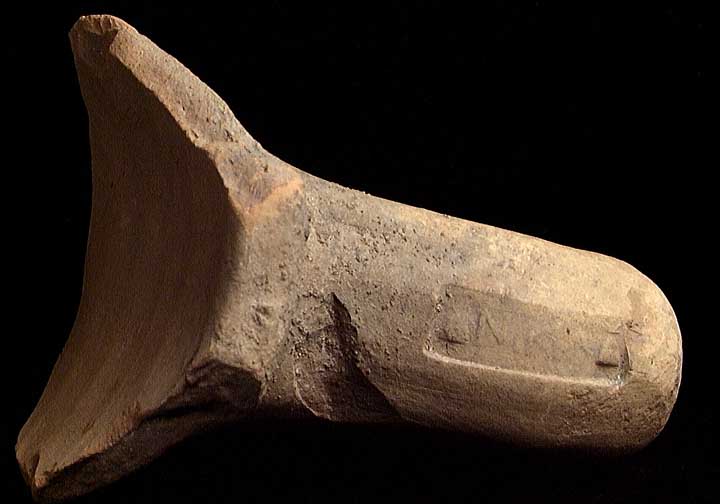
SOLD.
7636. AN EARLY GREEK OIL LAMP, c. 6th-5th century BC. The circular lamp with wide shallow opening. 3.25 inches. Rare early type.
SOLD.
7625. CHOICE GREEK LEAD SLING BULLET. Eastern Sicily, c. 4th-1st century BC. Clear letters both sides. An especially large example in excellent condition with an ancient impact mark. 1.75 inches.
SOLD.
7994. GREEK TWO HANDLED AMPHORA, c. 5th-3rd century BC. 9", intact.
SOLD.
8117. FINE LATE GREEK LAMP, c. 1st century BC/AD. The round lamp with fluted shoulders, four palm fronds on the discus. 4.25 inches. Intact.
SOLD.
7239. AN UNUSUAL RARE EARLY GREEK OIL LAMP, c. 4th century BC. The small lamp of typical simple form but on a high pedestal base. 2.5 inches long x 2.25 inches high.
SOLD.
7308. GREEK TERRA COTTA HEAD OF A GOD OR HERO, LIKELY ALEXANDER THE GREAT, c. 3rd-1st century BC. Handsome finely modeled face with wavy hair covering the head. 1.5 x 2 inches. Excellent quality.
SOLD.
6299. Greek amphora handle w stamp, dolphin 31 mm x 20 mm.
SOLD 3/30/12 at $300.
6289. A GREEK BRONZE MIRROR, c. 5th-1st century BC. 7.25 inches. Nice condition. Rare.
SOLD.
7870. GREEK GOLD SNAKE RING, c. 3rd-1st century BC. Beaten high-carat gold with snake heads both ends, incised details on heads and scales. 22mm but size is adjustable. Rare.
SOLD.
6300. Greek amphora handle w stamp, 26 mm x 16 mm.
SOLD.
6755. A LARGE GREEK TERRA COTTA EROS, c. 4th century BC. 8.2 inches. Intact. Rare this nice.
SOLD.
6291. Attic salt dish, mid of IV c BC, blackglazed, stamped central medallion w 7 palmettes, 2.3" x 0.7".
SOLD.
6292. Attic dish, IV c BC, black glazed, stamped central medallion w 4 palmettes, 4.2" x 1.4"
SOLD.
6293. Attic kylix, first 1/2 of V cBC, mended, 10.7"x 2.5", evidence of ancient repair (drill holes).
SOLD.
6757. A GREEK CORE GLASS AMPHORISKOS, c. 5th-3rd century BC. Blue, yellow mosaic glass. One handle professionally restored. 3.2".
SOLD.
6758. AN HELLENISTIC CORE GLASS AMPHORISKOS, c. 3rd-1st century BC. Combed white & blue glass. Repair with some restoration. 2.8". On custom stand.
SOLD.
6777. Black glazed skyphos, V c BC, Attica, H 3.8", mended.
SOLD.
6778. Attic red figure lekythos, IV c. BC, H 3.5", mended from 3 pieces.
SOLD.
6779. Athenian oil lamp, second half of III c. AD, L 4.1".
SOLD.
6780. Sarmatian bronze pendant, I-II cc AD, warrior figure, 26 mm.
SOLD.
6781. Sarmatian jar, I c BC-I c AD, gray-burnished, intact, H 5.4".
SOLD.
6782. 2 Sarmatian mirrors, I-II c AD, bronze & silver alloy, up to 2". Uncleaned.
SOLD.
6783. 2 Sarmation mirrors, I-II c AD, bronze & silver alloy, up to 2.7". Uncleaned.
SOLD.
6784. Archaic bronze mirror, mid VI c. BC, L 12.6", intact.
SOLD.
6785. A GREEK IVORY CARVING OF ATHENA’S OWL, c. 5th-3rd century BC. Finely carved owl seated on a pedestal. Characteristic green ancient ivory discolorations on ends. 23mm. Very rare!
SOLD.
6786. A GREEK BRONZE BOWL, 4th-2nd century BC. Formed with large omphalos at center, some ancient deposits. 6". Slightly out of shape.
SOLD.
6787. A HELLENISTIC BRONZE BOWL, ca. 1st-3rd century BC. The bowl with rounded bottom and carinated rim. 5.8". Intact.
SOLD.
6789. A HELLENISTIC BRONZE OIL LAMP, c. 3rd-4th century BC. Of elongated form with small leaf handle. 5". Rare.
SOLD.
7365. GREEK GEOMETRIC FIGURE OF A HORSE, c. 8th-6th century BC. Intact but for an ear with some surface abrasion. 2.75 x 2.75 inches. Rare early Greek terra cotta.
SOLD.
7979. ARCHAIC GREEK GODDESS HEAD, c. 6th century BC. Wearing high polos. 7 cm. Rare.
SOLD.
7980. LARGE ARCHAIC GREEK GODDESS HEAD, c. 5th century BC. Wearing polos. 9 cm. Rare, some recutting to face and hair.
SOLD.
7982. ETRUSCO-CORINTHIAN OLPE, c. 600 BC. The piriform bottle on wide ring base tapering to a slim neck with wide rim, bands of reddish brown glaze. 15 cm. Intact with some abrasion to the surface.
SOLD.
7997. HELLENISTIC PIRIFORM ARYBALLOS, c. 3rd-2nd century BC. 8 inches. Base lost.
SOLD.
8013. LARGE GREEK VOTIVE HEAD OF A GODDESS, c. 6th-5th century BC. The head repaired. 5 x 7 inches. A large example which could be greatly improved with a little work.
SOLD.
8014. 8 VOTIVE GREEK GODDESS HEADS, c. 6th-4th century BC. With repairs or wear. To 3.5 inches. Largest still has fingerprints of the ancient maker!
SOLD.
7637. AN EARLY GREEK OIL LAMP, c. 6th-5th century BC. The circular lamp with wide shallow opening. 2.75 inches. Rare early type.
HOME > GALLERIES > TOP
